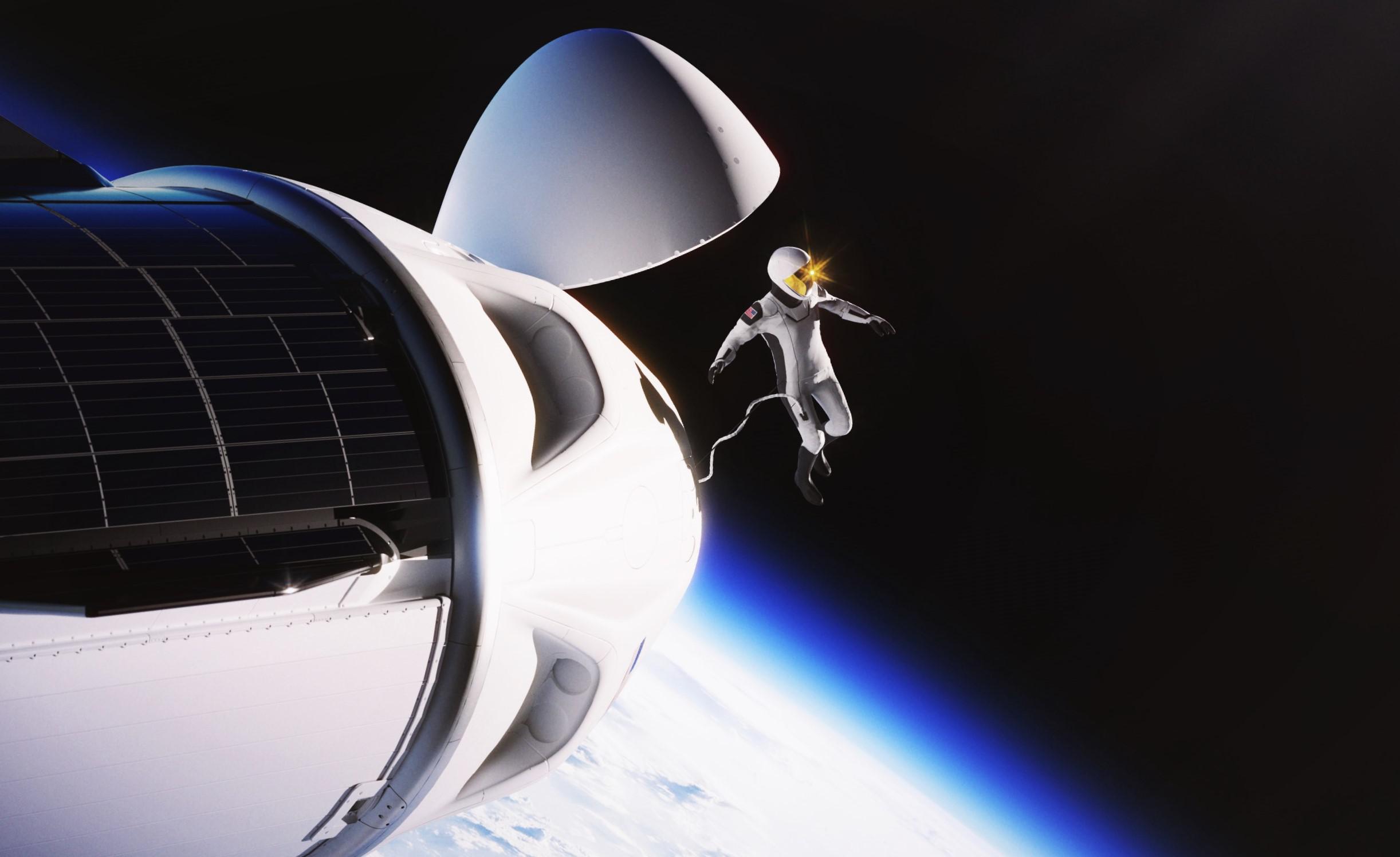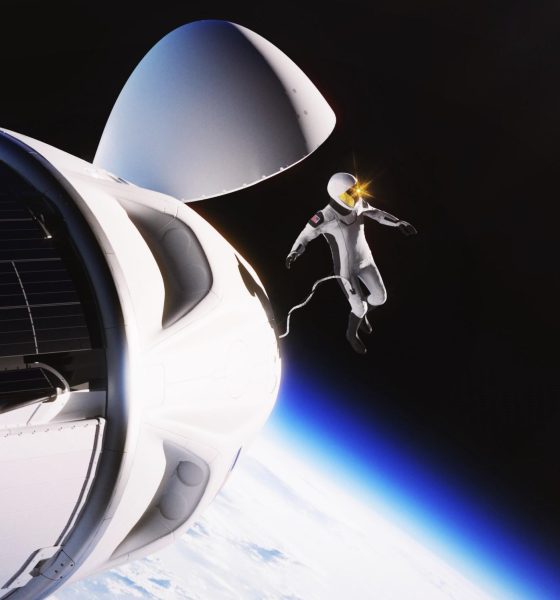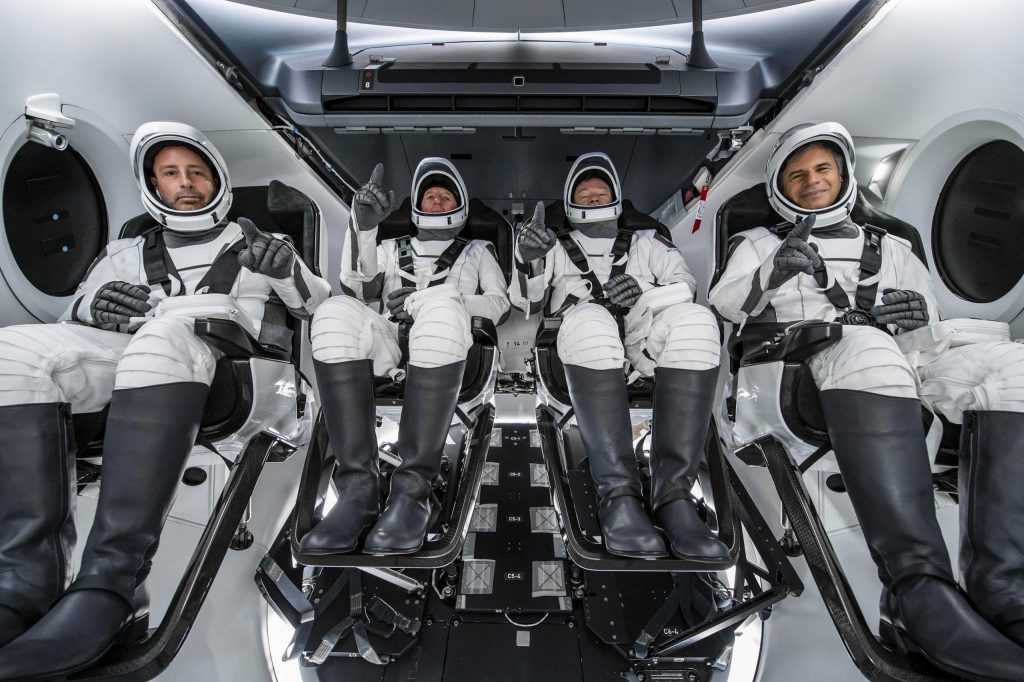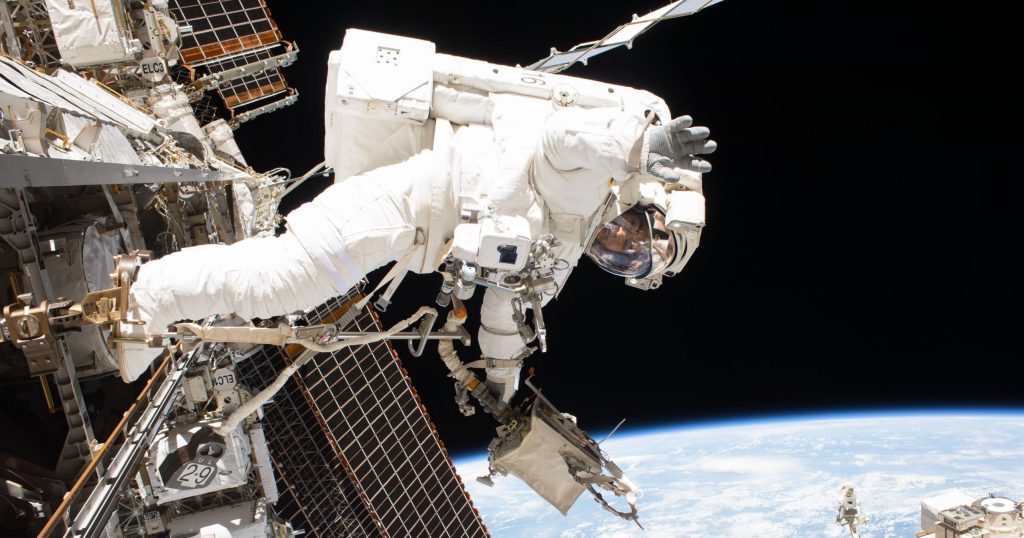

News
SpaceX ready to begin training astronauts for first private spacewalk
Two members of the “Polaris Program” say that SpaceX could begin training private astronauts for the first private spacewalk in spaceflight history as early as May or June 2022.
Revealed earlier this year, the Polaris Program is a sort of hybridization of orbital spaceflight tourism and technology development and has one primary goal: to “rapidly advance human spaceflight capabilities.” Created in partnership with SpaceX by billionaire and Shift4 Payments founder Jared Isaacman, who also funded and flew on SpaceX’s first private Crew Dragon launch, Polaris aims to pick up where Inspiration4 left off last year.
While it will still be affiliated with and seek to help St. Jude Children’s Research Hospital, the Polaris Program will focus on the development of several crucial technologies that SpaceX will need to accomplish its ultimate goal of spreading humanity throughout our solar system.
One of those crucial technologies is a cheap, reliable, and easy-to-use spacesuit that will allow future SpaceX astronauts to work outside of the safety of their spacecraft in the vacuum of space, and, one day, walk on the surfaces of other planets and moons. For Crew Dragon, SpaceX has already developed an ‘intra-vehicular activity’ or IVA pressure suit that all Dragon astronauts must wear during mission-critical maneuvers. In the event of capsule depressurization, the suits would be able to keep Dragon astronauts alive inside the capsule for at least a few days, supplying them with clean air and maintaining enough pressure to avoid altitude sickness (or worse).
However, because IVA suits generally prioritize unpressurized mobility, the astronauts inside them can do very little when the suits are fully pressurized. At sea level, every person on Earth is subjected to standard atmospheric pressure, which amounts to about 101 kilopascals or 14.5 pounds per square inch. In a spacesuit, the suit itself must maintain a pocket of air at similar pressures, ultimately meaning that the outer skin of a suit must resist the same force. To put that into context, even operating at the absolute minimum pressures that humans can realistically tolerate and use (4-6 psi), simply moving one’s arm in an IVA suit could require hundreds of pounds or kilograms of force.

Even in NASA’s aging extra-vehicular activity (EVA) spacesuits, which feature mechanical joints and other upgrades meant to make movement and life easier inside them, spacewalks are one of the most brutal and exhausting physical activities conceivable, requiring extraordinary levels of near-constant exertion for hours on end. According to comments made to Spaceflight Now by Jared Isaacman and by pilot Scott Poteet in an interview covered by AmericaSpace, SpaceX’s first EVA suit will be quite basic. To some extent, they will be heavily modified versions of SpaceX’s existing IVA suit design, but with much more advanced thermal management, an improved helmet/visor, and – most importantly – the addition of a number of mechanized joints.


As was the case with early NASA EVA suits developed in the 1960s, SpaceX’s first EVA suits will receive consumables, power, and communications through cables (tethers) that connect to Dragon’s life support. It will take SpaceX some time to develop a miniaturized, portable life support system as safe and capable as the packs used on NASA’s EVA suits. A tethered EVA suit will still allow SpaceX or private astronauts to perform EVAs and work on or inspect the exterior of their Crew Dragon or Starship spacecraft – capabilities that could save lives in certain emergency scenarios. SpaceX’s first priority, then, will be to make sure that the basics work well in space and that the suits actually allow astronauts to perform tasks that require good finger and limb dexterity without immediately exhausting themselves.
“You’re adding lots of redundancies in the suit that don’t exist today, since it’s more last line of defense,” Isaacman said, referring to the differences between SpaceX’s current suit and the new extravehicular spacesuit. “You have a new visor, new seals, then mobility, joints everywhere for increased mobility and dexterity in the fingers and such. I think, visually, it will be more along the lines of what it currently looks like, but very much like a new suit.”
Spaceflight Now – May 10th, 2022
The first of up to three Polaris missions – Polaris Dawn – is currently scheduled to launch as early as November 2022. All four private astronauts – made up of two Polaris employees and two SpaceX employees – will wear the new EVA suits in place of their usual IVA suits, while only two members of the crew will ultimately attempt to exit the capsule and perform a single EVA that could last roughly 30-90 minutes. To do so, the entire Dragon will be depressurized and one of two hatches opened will be opened, while the the other two EVA-suited astronauts will simply remain in their seats. Regardless of the outcome, it will be the first private spacewalk in the history of spaceflight.
The astronauts training to prepare for Polaris Dawn will focus heavily on the EVA, offering either the two chosen crew members or all four candidates an opportunity to experience deep-sea diving and test EVA suits both underwater and inside a Dragon capsule simulator.
Beyond supporting SpaceX’s EVA spacesuit development, Polaris Dawn’s crew will also conduct a range of science experiments, attempt to connect to high-speed internet in orbit through Starlink laser links, and even try to break the record for the highest Earth orbit reached by a crewed spacecraft (1400 km / 870 mi).

Elon Musk
Elon Musk’s X will start using a Tesla-like software update strategy
The initiative seems designed to accelerate updates to the social media platform, while maintaining maximum transparency.

Elon Musk’s social media platform X will adopt a Tesla-esque approach to software updates for its algorithm.
The initiative seems designed to accelerate updates to the social media platform, while maintaining maximum transparency.
X’s updates to its updates
As per Musk in a post on X, the social media company will be making a new algorithm to determine what organic and advertising posts are recommended to users. These updates would then be repeated every four weeks.
“We will make the new 𝕏 algorithm, including all code used to determine what organic and advertising posts are recommended to users, open source in 7 days. This will be repeated every 4 weeks, with comprehensive developer notes, to help you understand what changed,” Musk wrote in his post.
The initiative somewhat mirrors Tesla’s over-the-air update model, where vehicle software is regularly refined and pushed to users with detailed release notes. This should allow users to better understand the details of X’s every update and foster a healthy feedback loop for the social media platform.
xAI and X
X, formerly Twitter, has been acquired by Elon Musk’s artificial intelligence startup, xAI last year. Since then, xAI has seen a rapid rise in valuation. Following the company’s the company’s upsized $20 billion Series E funding round, estimates now suggest that xAI is worth tens about $230 to $235 billion. That’s several times larger than Tesla when Elon Musk received his controversial 2018 CEO Performance Award.
As per xAI, the Series E funding round attracted a diverse group of investors, including Valor Equity Partners, Stepstone Group, Fidelity Management & Research Company, Qatar Investment Authority, MGX, and Baron Capital Group, among others. Strategic partners NVIDIA and Cisco Investments also continued support for building the world’s largest GPU clusters.
News
Tesla FSD Supervised wins MotorTrend’s Best Driver Assistance Award
The decision marks a notable reversal for the publication from prior years, with judges citing major real-world improvements that pushed Tesla’s latest FSD software ahead of every competing ADAS system.

Tesla’s Full Self-Driving (Supervised) system has been named the best driver-assistance technology on the market, earning top honors at the 2026 MotorTrend Best Tech Awards.
The decision marks a notable reversal for the publication from prior years, with judges citing major real-world improvements that pushed Tesla’s latest FSD software ahead of every competing ADAS system. And it wasn’t even close.
MotorTrend reverses course
MotorTrend awarded Tesla FSD (Supervised) its 2026 Best Tech Driver Assistance title after extensive testing of the latest v14 software. The publication acknowledged that it had previously criticized earlier versions of FSD for erratic behavior and near-miss incidents, ultimately favoring rivals such as GM’s Super Cruise in earlier evaluations.
According to MotorTrend, the newest iteration of FSD resolved many of those shortcomings. Testers said v14 showed far smoother behavior in complex urban scenarios, including unprotected left turns, traffic circles, emergency vehicles, and dense city streets. While the system still requires constant driver supervision, judges concluded that no other advanced driver-assistance system currently matches its breadth of capability.
Unlike rival systems that rely on combinations of cameras, radar, lidar, and mapped highways, Tesla’s FSD operates using a camera-only approach and is capable of driving on city streets, rural roads, and freeways. MotorTrend stated that pure utility, the ability to handle nearly all road types, ultimately separated FSD from competitors like Ford BlueCruise, GM Super Cruise, and BMW’s Highway Assistant.
High cost and high capability
MotorTrend also addressed FSD’s pricing, which remains significantly higher than rival systems. Tesla currently charges $8,000 for a one-time purchase or $99 per month for a subscription, compared with far lower upfront and subscription costs from other automakers. The publication noted that the premium is justified given FSD’s unmatched scope and continuous software evolution.
Safety remained a central focus of the evaluation. While testers reported collision-free operation over thousands of miles, they noted ongoing concerns around FSD’s configurable driving modes, including options that allow aggressive driving and speeds beyond posted limits. MotorTrend emphasized that, like all Level 2 systems, FSD still depends on a fully attentive human driver at all times.
Despite those caveats, the publication concluded that Tesla’s rapid software progress fundamentally reshaped the competitive landscape. For drivers seeking the most capable hands-on driver-assistance system available today, MotorTrend concluded Tesla FSD (Supervised) now stands alone at the top.
News
Elon Musk’s Grokipedia surges to 5.6M articles, almost 79% of English Wikipedia
The explosive growth marks a major milestone for the AI-powered online encyclopedia, which was launched by Elon Musk’s xAI just months ago.

Elon Musk’s Grokipedia has grown to an impressive 5,615,201 articles as of today, closing in on 79% of the English Wikipedia’s current total of 7,119,376 articles.
The explosive growth marks a major milestone for the AI-powered online encyclopedia, which was launched by Elon Musk’s xAI just months ago. Needless to say, it would only be a matter of time before Grokipedia exceeds English Wikipedia in sheer volume.
Grokipedia’s rapid growth
xAI’s vision for Grokipedia emphasizes neutrality, while Grok’s reasoning capabilities allow for fast drafting and fact-checking. When Elon Musk announced the initiative in late September 2025, he noted that Grokipedia would be an improvement to Wikipedia because it would be designed to avoid bias.
At the time, Musk noted that Grokipedia “is a necessary step towards the xAI goal of understanding the Universe.”
Grokipedia was launched in late October, and while xAI was careful to list it only as Version 0.1 at the time, the online encyclopedia immediately earned praise. Wikipedia co-founder Larry Sanger highlighted the project’s innovative approach, noting how it leverages AI to fill knowledge gaps and enable rapid updates. Netizens also observed how Grokipedia tends to present articles in a more objective manner compared to Wikipedia, which is edited by humans.
Elon Musk’s ambitious plans
With 5,615,201 total articles, Grokipedia has now grown to almost 79% of English Wikipedia’s article base. This is incredibly quick, though Grokipedia remains text-only for now. xAI, for its part, has now updated the online encyclopedia’s iteration to v0.2.
Elon Musk has shared bold ideas for Grokipedia, including sending a record of the entire knowledge base to space as part of xAI’s mission to preserve and expand human understanding. At some point, Musk stated that Grokipedia will be renamed to Encyclopedia Galactica, and it will be sent to the cosmos.
“When Grokipedia is good enough (long way to go), we will change the name to Encyclopedia Galactica. It will be an open source distillation of all knowledge, including audio, images and video. Join xAI to help build the sci-fi version of the Library of Alexandria!” Musk wrote, adding in a later post that “Copies will be etched in stone and sent to the Moon, Mars and beyond. This time, it will not be lost.”








